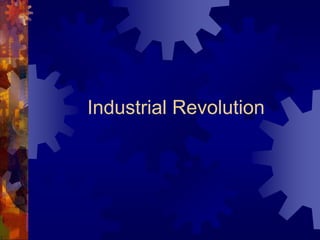
How the US Became a Leading Industrial Nation by Early 1900s
- 3. By early 1900s, US world’s leading industrial nation. Fueled by: Abundant supply of natural resources Improved transportation transcontinental railroad moving resources and people Increase in labor force 1860-1910 population tripled Greater demand for consumer goods Large workforce
- 4. Gov’t supported industrialization: Helped industries with loans & minimal regulation Railroad construction subsidized by gov’t Loans and land grants Maintained laissez-faire approach Imposed few regulations Viewed labor organizations with suspicion High tariffs on imports to protect domestic industry Contradicted laissez-faire Caused foreign nations to raise tariffs Increased cost of American goods
- 5. The Men who Built America- History Channel Series Traits of a “TITAN” PREVIEW 2 pages of handwritten notes over 1 episode = 2 FREE 100s 5 different episodes Rockefeller Carnegie JP Morgan/Edison Ford Vanderbuilt
- 7. Steel… Affected technological change more than any other product Allowed for cheaper building materials Bessemer Process Cold air pressure method of transforming iron ore into steel Andrew Carnegie- Steel Tycoon Believed in SOCIAL GOSPEL movement-financed Public Libraries GOSPEL OF WEALTH: Believed it was wealthy’ s obligation to contribute to society (part of the social gospel movement) Philanthropist
- 9. Oil and Electricity Oil could be refined into gasoline, kerosene, and distillate John D. Rockefeller Standard Oil Co. Own all aspects of production Oil wells, refineries, retail outlets Controlled 90% of world’s oil trade Edison Electric Illuminating Co. Supplied electric power to New York City
- 10. Railroads & Banks “Commodore” Vanderbilt Railroad monopoly American industrialist and philanthropist who built his wealth in shipping and railroads J.P. Morgan Monopoly of the BANKS Interlocking directorates In 1892 Morgan arranged the merger of Edison General Electric and Thomson- Houston Electric Company to form General Electric (AKA GE)
- 11. The Assembly Line Henry Ford popularized use in manufacturing Combined sub-assembly lines into one continuous moving line Divided operation into simple tasks Workers performed same task repeatedly Unskilled workers could perform tasks Allowed for faster production Reduced cost of automobile Efficiency!!!!
- 12. Railroads Pacific Railway Act provided for construction of transcontinental RR Transcontinental Railroad Gov’t gave land along right-of-way to encourage rapid construction Sold land to pay for costs Union Pacific RR-built East to West from Omaha, NE Central Pacific RR-built West to East from Sacramento, CA Hired workers from China Joined May 10, 1869 near Ogden Utah
- 13. Big Business cont’d. Competition creates lower prices Without competition, monopolies form Vertical integration (Carnegie) One company owns all other businesses it takes to make finished product Chair Co = Cloth Co + Frame Co + Shipping Co Horizontal integration (Rockefeller/J.P. Morgan) One large company owns several smaller companies doing the same type business Mega Convenience Store = Allsups + Pak-a-Sak + Toot-n-Totum
- 14. Negative View of Industry SOCIAL DARWINISM- The belief that society was much like nature and only the “strong” survived Large monopolists often used this theory to defend their immense fortunes and ill treatment of workers • Often times the “INDUSTRIALISTS” were referred to as “ROBBER BARRONS” or “TITANS OF INDUSTRY” because of their unethical and power hungry strategies
- 18. Factory Work in US Life in the factory— Unsafe work environment No gov’t regulations Low pay Long hours Tedious, monotonous jobs—no skills required Unions Great length to keep out of factories Samuel Gompers—first leader of American Federation of Labor Fought for higher wages, better working conditions
- 19. Knights of Labor Terence V. Powderly • Open membership (skilled, unskilled, women, children, immigrants and African Americans • Goals was to create a cooperative society in which laborers and capitalists were equal • Were blamed for Haymarket Square Riot unfairly and became known as anarchists/violence Industrial Workers of the World (IWW) • “Mother” Jones • Elizabeth Flynn • Big Bill Haywood • Like Knights in that they strove to unite all workers (open membership) • Motto: “An injury to one is an injury to all” • Embraced class conflict and violent tactics • Small union (150,000) American Federation of Labor “AFL” Samuel Gompers • Alliance of SKILLED workers • Concentrated on “Bread and Butter issues” such as higher wages, shorter hours and better working conditions
- 22. Famous Strikes of the Industrial Revolution Homestead Strike (1892) “Lock out” by one of Carnegie’s steel mills near Pittsburgh Carnegie supported Unions but the “Chairman” of US Steel, Henry Frick, wanted to break the Union at Homestead Turned violent and very public
- 23. Famous Strikes of the Industrial Revolution Haymarket Riot Nationwide Strike to support an 8-hour workday A clash between strikers and police leaves one dead in Chicago’s Haymarket Square Bomb thrown by strikers…Police open fired 7 police dead 4 workers killed The Pullman Strike Pullman Palace Rail Car Co. had to cut wages because of hard economic times Workers had unionized under the ARU (American Railway Union Leader: Eugene V. Debs ARU boycotts Pullman Railcars Entire US’s rails are shut down President Cleveland has to send it troops to stop boycott
- 24. The Great Railroad Strike of 1877 Panic of 1873 (recession) forces companies to cut wages This causes 1st NATIONWIDE Labor protest Rail workers walked off job, blocked tracks and destroyed Rail Co. property President Hayes ends up sending troops in to put to order and stop violence
- 25. The Impact of Industry Industrial Revolution at first not benefit everyone equally National wealth and personal income grew significantly by 1920s Cheaper consumer goods on market